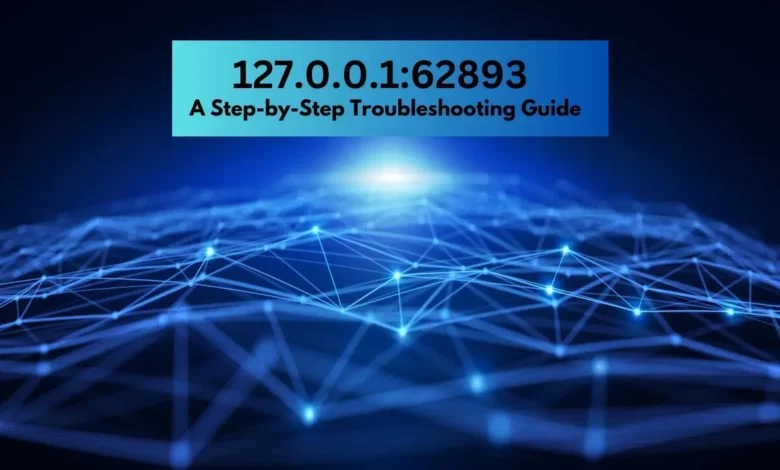Troubleshooting 127.0.0.1:62893: A Step-by-Step Guide

In the world of networking and computer systems, encountering errors related to specific IP addresses and ports can be a common yet frustrating experience. One such instance is dealing with issues related to the local IP address 127.0.0.1 and port 62893. Understanding and troubleshooting problems associated with 127.0.0.1:62893 can save you time and ensure the smooth operation of your network services. This guide provides a comprehensive approach to diagnosing and resolving these issues, empowering you with the knowledge to tackle them effectively.
Understanding 127.0.0.1:62893
Before diving into troubleshooting, it’s essential to understand what 127.0.0.1:62893 represents. The IP address 127.0.0.1 is commonly referred to as the “loopback” address. It is a special address used by a computer to refer to itself. When you ping 127.0.0.1, you’re essentially sending a signal to your own machine, which is a useful way to verify that the network stack of your machine is working correctly.
Port 62893, on the other hand, is one of the many ports available for applications to use for communication. Ports are virtual endpoints of communication used to distinguish different services or applications on a single device. When you specify 127.0.0.1:62893, you’re typically referring to a service running on your local machine that is listening on port 62893.
Common Issues with 127.0.0.1:62893
Several problems can arise when dealing with 127.0.0.1:62893, ranging from simple misconfigurations to more complex network conflicts. Some of the most common issues include:
- Service Not Running: The application or service expected to be listening on port 62893 might not be running.
- Port Conflict: Another application might already be using port 62893, causing a conflict.
- Firewall Restrictions: Firewalls or security software may block the communication to or from port 62893.
- Configuration Errors: Incorrect configurations in the service or network settings can lead to connectivity issues.
- Software Bugs: Bugs or glitches in the application using 127.0.0.1:62893 can cause unexpected behavior.
Diagnosing the Problem
The first step in troubleshooting any network-related issue is diagnosing the problem. Here’s a structured approach to identify the root cause of issues with 127.0.0.1:62893.
Step 1: Verify the Service Status
Begin by checking whether the service you expect to be running on port 62893 is active. On a Unix-based system, you can use the netstat or ss command. For Windows, use the netstat command. If the service is not listed, it indicates that the application is not running or not listening on the specified port. Ensure the application is started and configured correctly to listen on port 62893.
Step 2: Check for Port Conflicts
To determine if another application is using port 62893, you can use similar commands as above. If you find multiple entries for port 62893, you need to identify and resolve the conflict. You can either change the port of the conflicting application or reconfigure your service to use a different port.
Step 3: Review Firewall Settings
Firewalls are essential for network security but can sometimes block legitimate traffic. Check your firewall settings to ensure that traffic on port 62893 is allowed. On Unix-based systems, you can use iptables or ufw to manage firewall rules. On Windows, use the Windows Firewall settings or netsh command. Ensure that there are rules permitting inbound and outbound traffic on port 62893.
Step 4: Analyze Configuration Files
Incorrect configurations are a common cause of connectivity issues. Review the configuration files of your application to ensure it is set to use 127.0.0.1 and port 62893 correctly. Look for typos, incorrect IP addresses, or misconfigured port numbers.
Step 5: Investigate Logs
Logs can provide valuable insights into what might be going wrong. Check the logs of your application for any error messages or warnings related to 127.0.0.1:62893. Logs can often point you to the exact cause of the issue, whether it’s a misconfiguration, a bug, or an external factor.
Step 6: Test with Telnet or Curl
Using tools like telnet or curl can help you test the connectivity to port 62893. If the connection is successful, it indicates that the service is running and reachable. If not, you need to further investigate the blockage.
Resolving Common Issues
Once you’ve diagnosed the problem, it’s time to take corrective actions. Here are some common resolutions for issues with 127.0.0.1:62893.
Restart the Service
If the service is not running, restarting it might solve the issue. Ensure the service is configured to start automatically if it’s critical for your operations.
Change Port Numbers
If there’s a port conflict, change the port number of either the conflicting application or your service. Ensure that the new port is available and not blocked by any firewall rules.
Update Firewall Rules
Modify your firewall settings to allow traffic on port 62893. Ensure both inbound and outbound rules are configured correctly.
Correct Configuration Files
Fix any errors in your configuration files. Double-check the IP address and port settings to ensure they match your intended configuration.
Apply Software Patches
If the issue is due to a bug in the software, check for updates or patches from the software vendor. Applying the latest updates can resolve known issues and improve stability.
Consult Documentation and Support
If the problem persists, consult the documentation of the application or service. Many software vendors provide detailed troubleshooting guides. Additionally, reaching out to technical support can provide further assistance.
Preventing Future Issues
Preventative measures can help avoid future problems with 127.0.0.1:62893. Here are some best practices:
Regular Monitoring
Implement regular monitoring of your network services. Use tools like Nagios, Zabbix, or Prometheus to keep an eye on the status of your services and ports.
Automated Backups and Rollbacks
Regularly back up your configuration files and have rollback procedures in place. This allows you to quickly revert to a known good state if an issue arises.
Security Audits
Conduct periodic security audits to ensure your firewall and network settings are optimal and not overly restrictive.
Documentation
Maintain comprehensive documentation of your network configuration, including details of all services and their respective ports. This makes troubleshooting easier and faster.
Conclusion
Troubleshooting issues with 127.0.0.1:62893 can be straightforward if approached methodically. By understanding what 127.0.0.1:62893 represents and following a structured diagnostic process, you can identify and resolve most issues efficiently. Remember to verify service status, check for port conflicts, review firewall settings, analyze configuration files, investigate logs, and test connectivity. Taking these steps not only helps in resolving current issues but also in preventing future ones, ensuring a stable and secure network environment.



